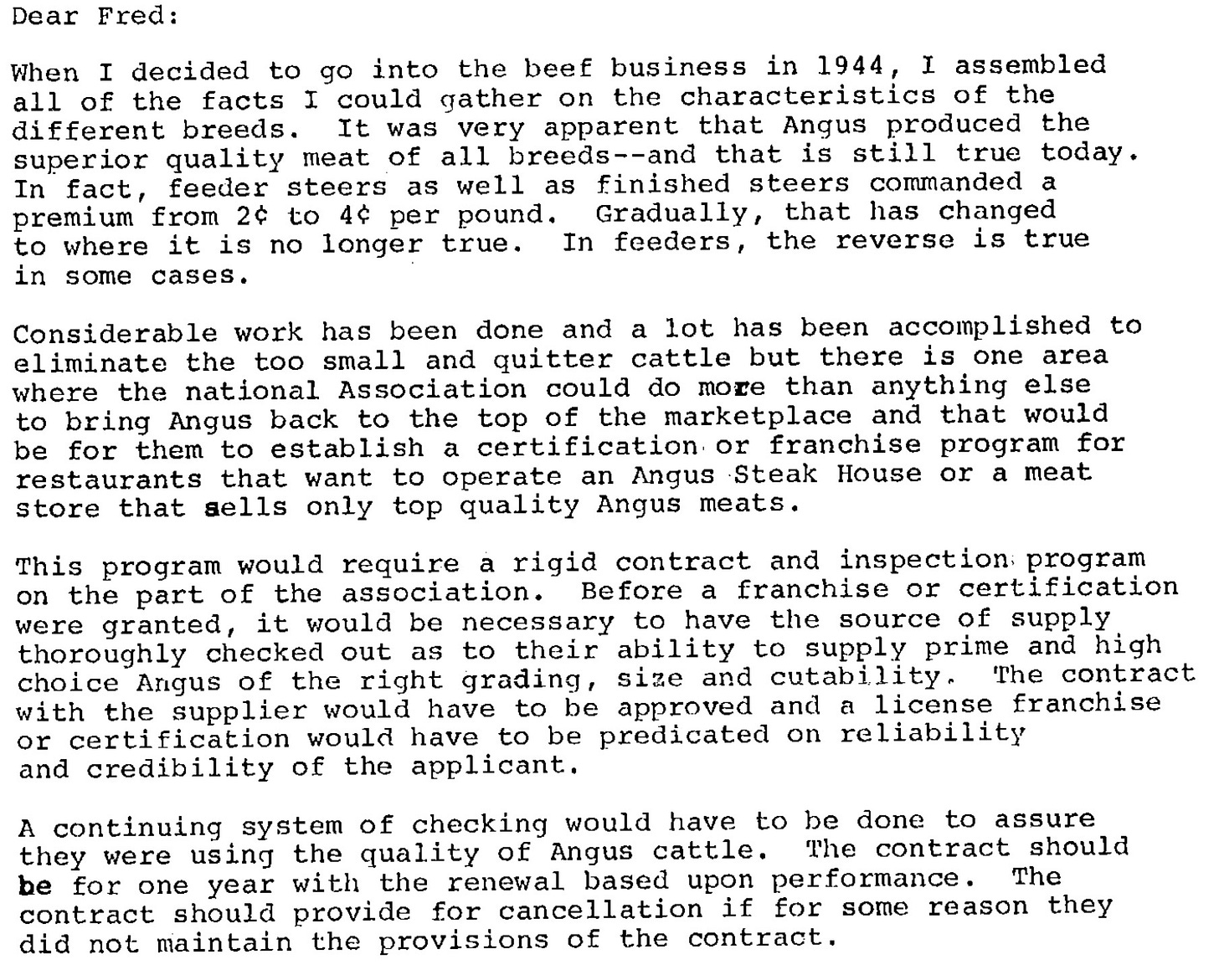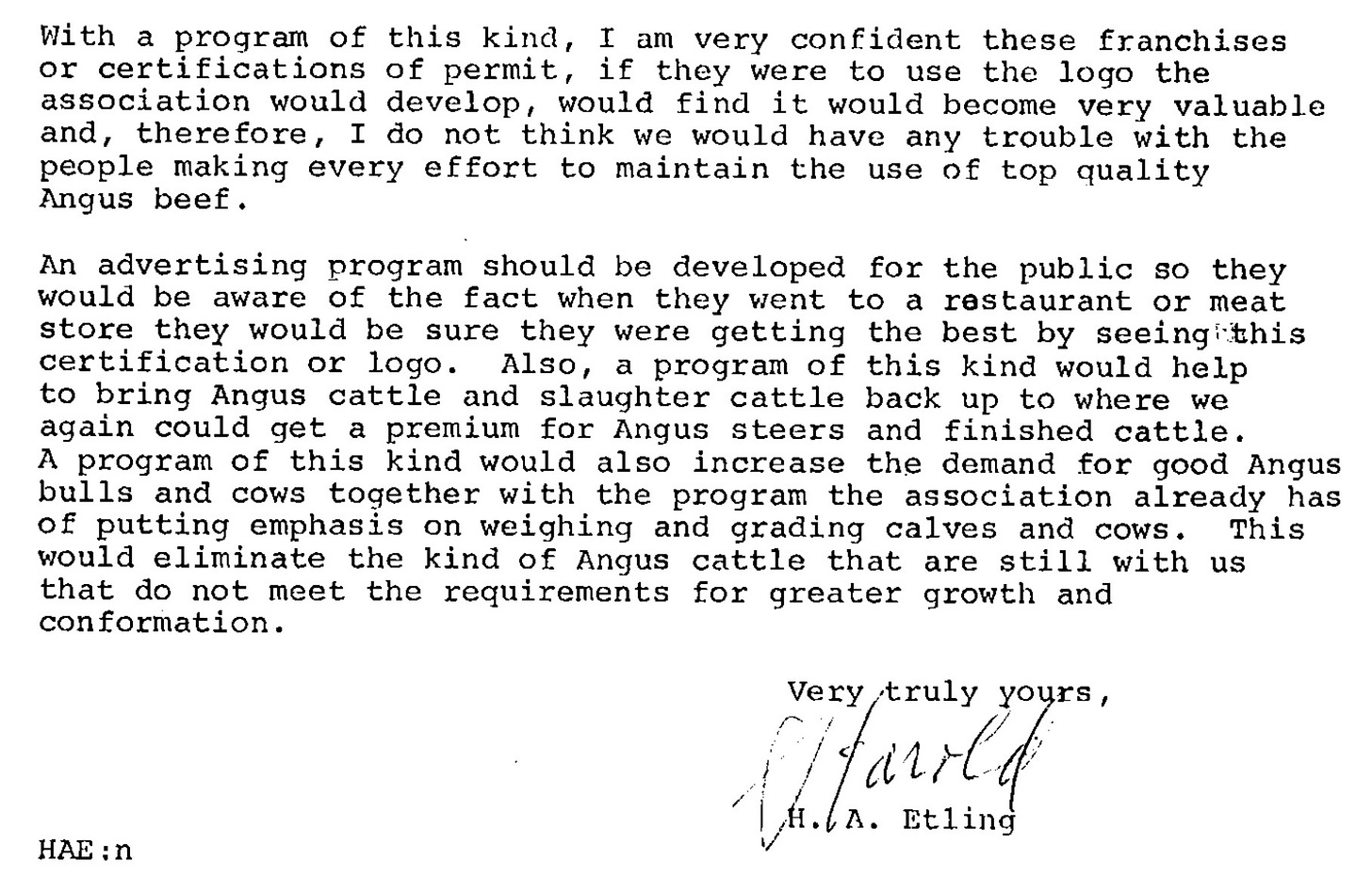1975 should call the pork people
Prime Future 136: the newsletter for innovators in livestock, meat, and dairy
Does the name H.A. Etling mean anything to you? Me neither, until recently.
What about Certified Angus Beef, does that ring a bell? Of course.
We’ve looked at the Eggland's Best model, an OG asset-light business model. But CAB is an even earlier asset-light business model; CAB is the largest beef brand that owns no cattle, no packing plants, no shackle space.
CAB generates revenue by licensing the use of its brand to packers, so its sole function is limited to generating demand for CAB-branded beef.
And yet according to CAB’s website:
"Ninety-five percent of consumers recognize the brand name, and consumers rank our brand most often as the best among all grades, types and brands of beef. More than 16,000 restaurants and grocery stores worldwide feature the brand."
That 95% number is 🤯. The CAB brand sold more than 1.234 billion pounds of beef in FY 2022 making it by far the largest and most well-recognized beef brand in the US.
In a world where building a brand is like scaling Mount Everest, especially building a brand that endures, here sits a non-profit doing the hard thing. It's hard to point to any single largest lifter of all boats with a bigger impact than CAB.
So what does H.A. Etling have to do with CAB, or innovators in livestock, meat, and dairy?
He was the producer mastermind behind the whole thing! An Angus cattle producer himself, he sent a letter in 1975 to the Angus Association outlining his idea for a franchise program for premium beef, which became CAB. Even today, CAB is almost identical to the original outlines of the program Mr. Etling proposed.
(The full letter is at the bottom of this newsletter and if Prime Future adds no other value to the world, I hope reading Mr. Etling's letter refreshes your sense of optimism that sometimes little ideas become big things.)
Now set Mr. Etling’s 1975 letter next to this 2023 article, The Pork Industry Needs its Wagyu Moment:
“A large portion of pork products at the grocery store are bland, resulting in disappointed customers and flat lined sales. We need to produce and market better tasting pork.”
“We as an industry have allowed inferior pork to become the standard. This is pork that is bland, dry, white, has no marbling, tastes awful, and leaves one wondering why they bought it in the first place. There’s a reason why bacon costs so much when compared to other cuts of pork – it has marbling, it has taste, and it’s universally loved by so many because of this.
Overall, meat consumption has actually gone up but pork consumption has not moved, why don’t people want to eat more pork? We need to be producing pork that consumers actually want to eat.”
Can I get an amen?
While the article raises some great points, I don't think the pork industry needs a Wagyu moment; that's like jumping straight from crawling to marathon running, skipping every step in between.
What the pork industry needs is an H.A. Etling moment.
The pork industry today needs some of the very things Mr. Etling said the beef industry needed in 1975, such as:
A franchise program
A rigid contract and inspection program for that franchise program
Mechanisms to verify the product meets program specs
A brand that people can recognize and an advertising program
But first, you need a quality grade system to underpin it all.
Somebody needs to porkify CAB to start creating a high quality and consistent eating experience for pork consumers. But there's a zero percent chance I'm the first person to say this.
So, people of pork: why hasn't this already happened?? What’s kept it from being a thing?
And since we’re in a series about everyone’s favorite words, you know CAB ties in 😁
CAB's model has allowed them to scale efficiently and to focus on the specific capability of marketing beef, something that if we're being really honest, most beef brands aren't great at.
And because of that model, CAB can make this claim: "Every pound of product is tracked from harvest to the consumer, ensuring the integrity of our product, logo and brand name."
But ‘harvest to consumer’ only describes the last 2-3 of the 5-7 total links in the beef value chain which highlights the challenge around traceability in a fragmented value chain without vertical integration.
In the absence of owning animals their entire life (and beyond), being able to track product from harvest to consumer IS the win.
Particularly since we're talking about tens of harvest facilities as opposed to hundreds of feedyards or hundreds of thousands of cow-calf producers.
This CAB example highlights that traceability & transparency can be sliced many different ways, particularly in longer, more fragmented, more complex supply chains. In beef, traceability &/or transparency sometimes cover birth to harvest to consumer and sometimes only cover birth to harvest or harvest to consumer.
Traceability & transparency capabilities are limited by the business model of a specific supply chain unless the industry’s traceability capabilities supersede a supply chain’s capabilities.
But then traceability & transparency are no longer competitive advantages, they are table stakes capabilities….unless taken to more granularity than the industry. And then you come full circle back to the question of who will pay for that additional granularity, can large brands get enough supply with high granularity of traceability &/or transparency, etc.
All that to say, we need more precise language to accurately describe the scope, depth, and degrees of traceability & transparency.
And finally, we can't talk about H.A. Etling without talking about the power of ideas that come from within an organization or industry.
The idea for CAB wasn't generated in a board room, it was generated by a cattle producer with a vision.
The idea that became Amazon Prime wasn't Jeff Bezos' idea, it was originally generated by a relatively junior engineer in a meeting with peers. (Here’s a fun article about it.)
And the idea for flaming hot Cheetos wasn't developed by product development or R&D. It came from a janitor.
The point? Innovative ideas are the purest meritocracy.
What a time to be alive 😉
If you are interested in partnering on a Sponsored Deep Dive, reach out here (link).
Previous Sponsored Deep Dives include:
the✨magic✨in solving invisible problems with M2X Group
Rising from the averages: a cattle story with the Beef Alliance








There is some very interesting/thought provoking research out of University of Illinois on if pork quality will ever matter. No matter how it’s looked at - color, pH, marbling - the gist is consumers won’t pay. Even most the pork “prime” programs have been a flop. The only variable that moved the needle on consumer acceptance: cooking it to 145. I think pork’s CAB moment will have to come outside of the quality space. National Pork Board has tried multiple times to get momentum behind a quality grading program and every time it’s gone nowhere. Ultimately, if a consumer is being told to pay more for a “premium” product that doesn’t taste significantly better than the lower quality (cheaper) alternative...it’s tough to build anything that sustains.